Holistic Nursing Approach in Palliative Care: End-of-Life Practices
VerifiedAdded on 2023/06/13
|6
|1636
|493
Essay
AI Summary
This essay delves into the importance of holistic nursing care in palliative settings, emphasizing the treatment of the whole person, encompassing mind, body, and soul, rather than focusing solely on physical ailments. It addresses the challenges nurses face, such as limited time and numerous patients, and suggests practical techniques to enhance the nurse-patient relationship and promote emotional, spiritual, and psychological well-being. These techniques include learning patients' names, maintaining eye contact, demonstrating genuine care, and respecting patients' spiritual and religious beliefs. The essay underscores the significance of empowering patients through education and involving them in their care plans to improve their overall quality of life and dignity. Ultimately, it advocates for a balanced approach to palliative care that integrates psychological, social, spiritual, and physical care to achieve the best possible outcomes for patients.
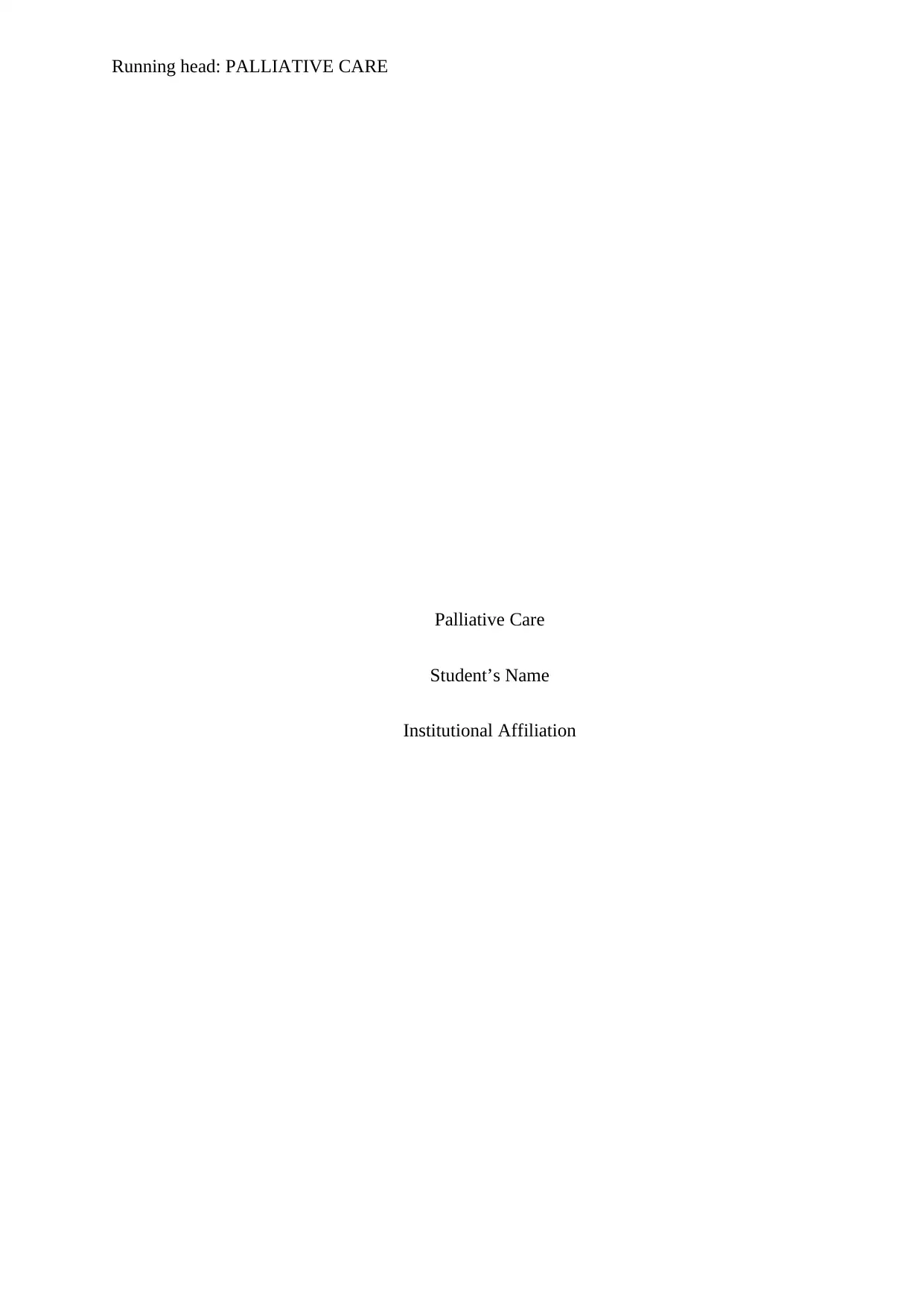
Running head: PALLIATIVE CARE
Palliative Care
Student’s Name
Institutional Affiliation
Palliative Care
Student’s Name
Institutional Affiliation
Paraphrase This Document
Need a fresh take? Get an instant paraphrase of this document with our AI Paraphraser
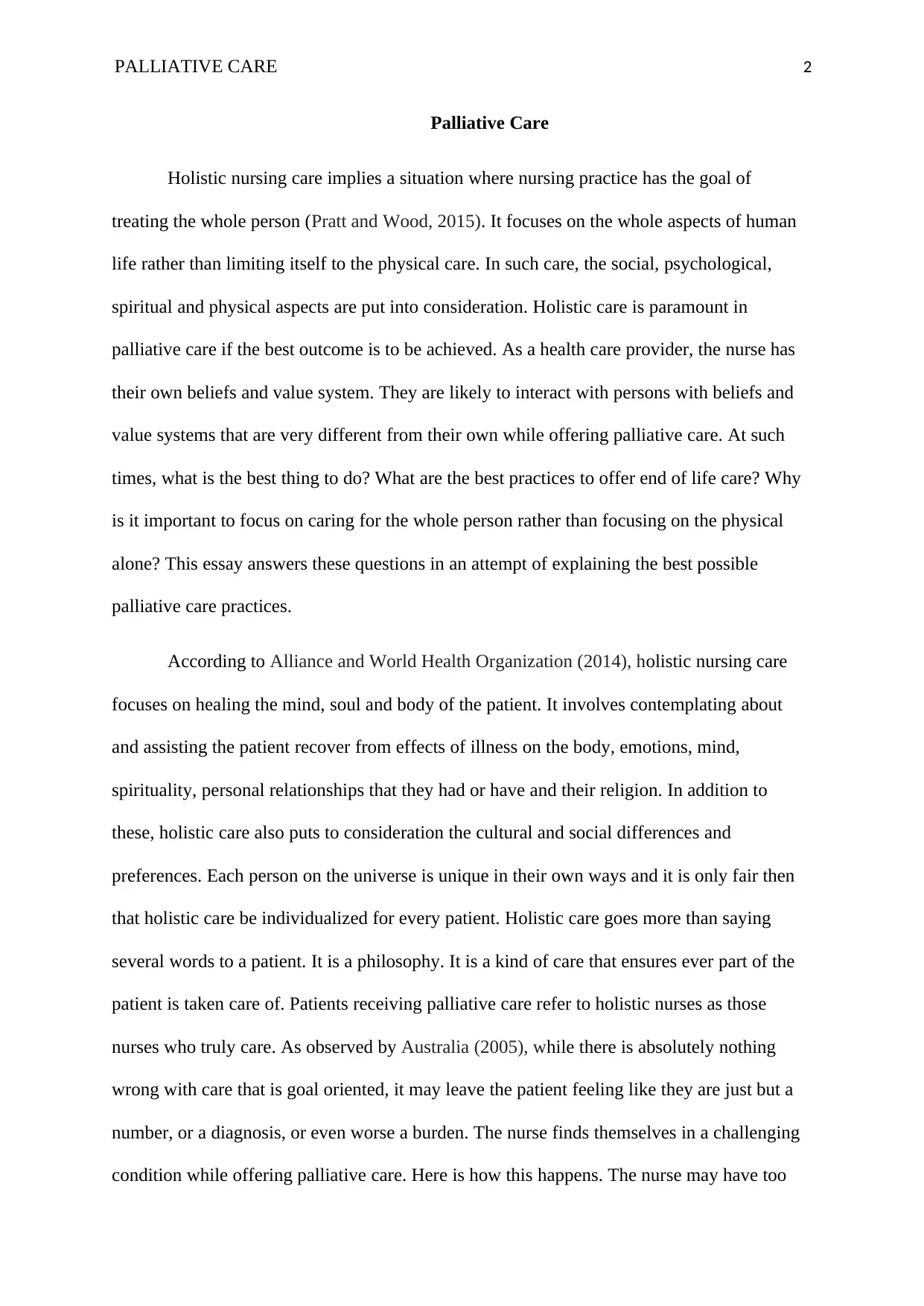
PALLIATIVE CARE 2
Palliative Care
Holistic nursing care implies a situation where nursing practice has the goal of
treating the whole person (Pratt and Wood, 2015). It focuses on the whole aspects of human
life rather than limiting itself to the physical care. In such care, the social, psychological,
spiritual and physical aspects are put into consideration. Holistic care is paramount in
palliative care if the best outcome is to be achieved. As a health care provider, the nurse has
their own beliefs and value system. They are likely to interact with persons with beliefs and
value systems that are very different from their own while offering palliative care. At such
times, what is the best thing to do? What are the best practices to offer end of life care? Why
is it important to focus on caring for the whole person rather than focusing on the physical
alone? This essay answers these questions in an attempt of explaining the best possible
palliative care practices.
According to Alliance and World Health Organization (2014), holistic nursing care
focuses on healing the mind, soul and body of the patient. It involves contemplating about
and assisting the patient recover from effects of illness on the body, emotions, mind,
spirituality, personal relationships that they had or have and their religion. In addition to
these, holistic care also puts to consideration the cultural and social differences and
preferences. Each person on the universe is unique in their own ways and it is only fair then
that holistic care be individualized for every patient. Holistic care goes more than saying
several words to a patient. It is a philosophy. It is a kind of care that ensures ever part of the
patient is taken care of. Patients receiving palliative care refer to holistic nurses as those
nurses who truly care. As observed by Australia (2005), while there is absolutely nothing
wrong with care that is goal oriented, it may leave the patient feeling like they are just but a
number, or a diagnosis, or even worse a burden. The nurse finds themselves in a challenging
condition while offering palliative care. Here is how this happens. The nurse may have too
Palliative Care
Holistic nursing care implies a situation where nursing practice has the goal of
treating the whole person (Pratt and Wood, 2015). It focuses on the whole aspects of human
life rather than limiting itself to the physical care. In such care, the social, psychological,
spiritual and physical aspects are put into consideration. Holistic care is paramount in
palliative care if the best outcome is to be achieved. As a health care provider, the nurse has
their own beliefs and value system. They are likely to interact with persons with beliefs and
value systems that are very different from their own while offering palliative care. At such
times, what is the best thing to do? What are the best practices to offer end of life care? Why
is it important to focus on caring for the whole person rather than focusing on the physical
alone? This essay answers these questions in an attempt of explaining the best possible
palliative care practices.
According to Alliance and World Health Organization (2014), holistic nursing care
focuses on healing the mind, soul and body of the patient. It involves contemplating about
and assisting the patient recover from effects of illness on the body, emotions, mind,
spirituality, personal relationships that they had or have and their religion. In addition to
these, holistic care also puts to consideration the cultural and social differences and
preferences. Each person on the universe is unique in their own ways and it is only fair then
that holistic care be individualized for every patient. Holistic care goes more than saying
several words to a patient. It is a philosophy. It is a kind of care that ensures ever part of the
patient is taken care of. Patients receiving palliative care refer to holistic nurses as those
nurses who truly care. As observed by Australia (2005), while there is absolutely nothing
wrong with care that is goal oriented, it may leave the patient feeling like they are just but a
number, or a diagnosis, or even worse a burden. The nurse finds themselves in a challenging
condition while offering palliative care. Here is how this happens. The nurse may have too
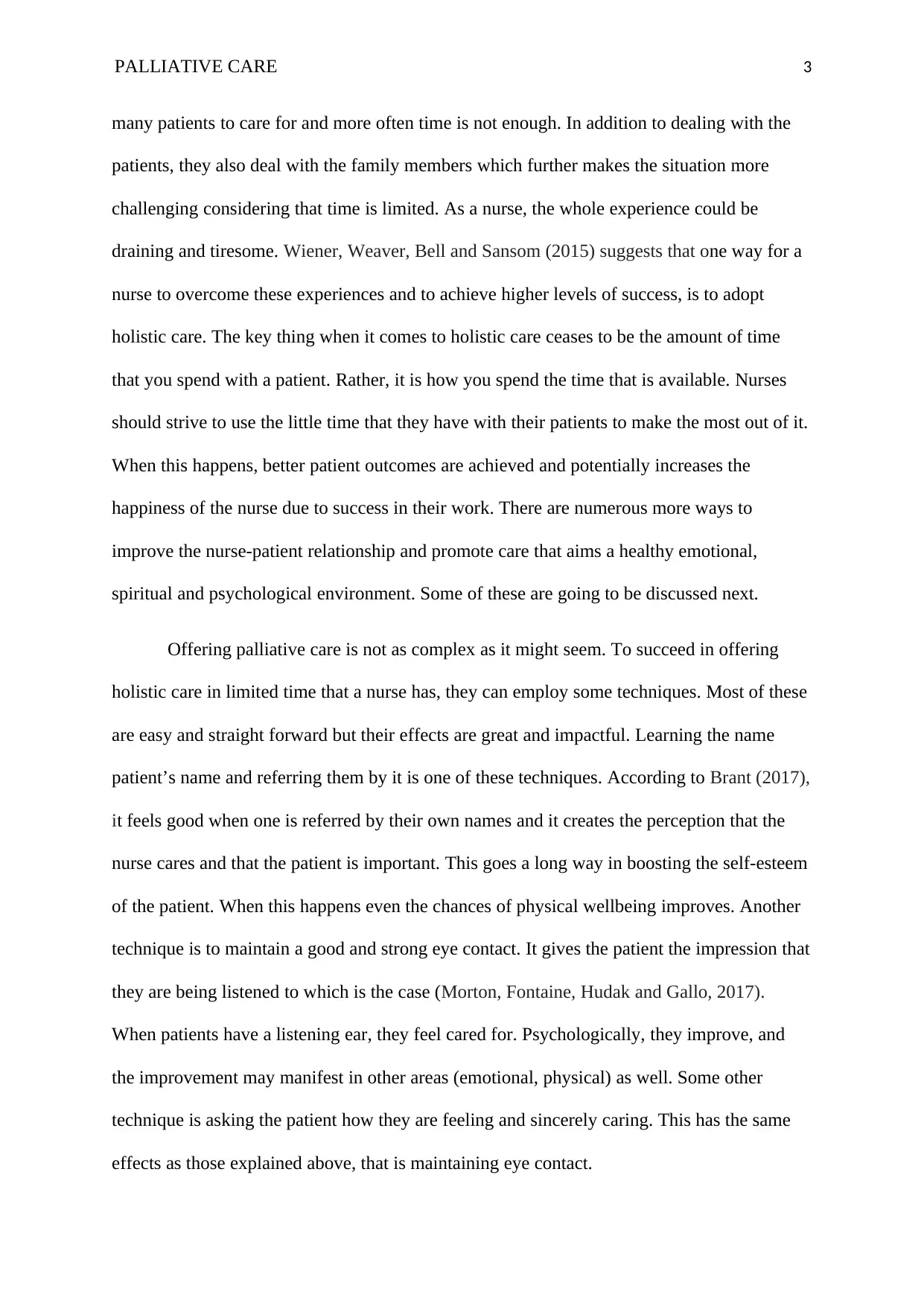
PALLIATIVE CARE 3
many patients to care for and more often time is not enough. In addition to dealing with the
patients, they also deal with the family members which further makes the situation more
challenging considering that time is limited. As a nurse, the whole experience could be
draining and tiresome. Wiener, Weaver, Bell and Sansom (2015) suggests that one way for a
nurse to overcome these experiences and to achieve higher levels of success, is to adopt
holistic care. The key thing when it comes to holistic care ceases to be the amount of time
that you spend with a patient. Rather, it is how you spend the time that is available. Nurses
should strive to use the little time that they have with their patients to make the most out of it.
When this happens, better patient outcomes are achieved and potentially increases the
happiness of the nurse due to success in their work. There are numerous more ways to
improve the nurse-patient relationship and promote care that aims a healthy emotional,
spiritual and psychological environment. Some of these are going to be discussed next.
Offering palliative care is not as complex as it might seem. To succeed in offering
holistic care in limited time that a nurse has, they can employ some techniques. Most of these
are easy and straight forward but their effects are great and impactful. Learning the name
patient’s name and referring them by it is one of these techniques. According to Brant (2017),
it feels good when one is referred by their own names and it creates the perception that the
nurse cares and that the patient is important. This goes a long way in boosting the self-esteem
of the patient. When this happens even the chances of physical wellbeing improves. Another
technique is to maintain a good and strong eye contact. It gives the patient the impression that
they are being listened to which is the case (Morton, Fontaine, Hudak and Gallo, 2017).
When patients have a listening ear, they feel cared for. Psychologically, they improve, and
the improvement may manifest in other areas (emotional, physical) as well. Some other
technique is asking the patient how they are feeling and sincerely caring. This has the same
effects as those explained above, that is maintaining eye contact.
many patients to care for and more often time is not enough. In addition to dealing with the
patients, they also deal with the family members which further makes the situation more
challenging considering that time is limited. As a nurse, the whole experience could be
draining and tiresome. Wiener, Weaver, Bell and Sansom (2015) suggests that one way for a
nurse to overcome these experiences and to achieve higher levels of success, is to adopt
holistic care. The key thing when it comes to holistic care ceases to be the amount of time
that you spend with a patient. Rather, it is how you spend the time that is available. Nurses
should strive to use the little time that they have with their patients to make the most out of it.
When this happens, better patient outcomes are achieved and potentially increases the
happiness of the nurse due to success in their work. There are numerous more ways to
improve the nurse-patient relationship and promote care that aims a healthy emotional,
spiritual and psychological environment. Some of these are going to be discussed next.
Offering palliative care is not as complex as it might seem. To succeed in offering
holistic care in limited time that a nurse has, they can employ some techniques. Most of these
are easy and straight forward but their effects are great and impactful. Learning the name
patient’s name and referring them by it is one of these techniques. According to Brant (2017),
it feels good when one is referred by their own names and it creates the perception that the
nurse cares and that the patient is important. This goes a long way in boosting the self-esteem
of the patient. When this happens even the chances of physical wellbeing improves. Another
technique is to maintain a good and strong eye contact. It gives the patient the impression that
they are being listened to which is the case (Morton, Fontaine, Hudak and Gallo, 2017).
When patients have a listening ear, they feel cared for. Psychologically, they improve, and
the improvement may manifest in other areas (emotional, physical) as well. Some other
technique is asking the patient how they are feeling and sincerely caring. This has the same
effects as those explained above, that is maintaining eye contact.
⊘ This is a preview!⊘
Do you want full access?
Subscribe today to unlock all pages.

Trusted by 1+ million students worldwide
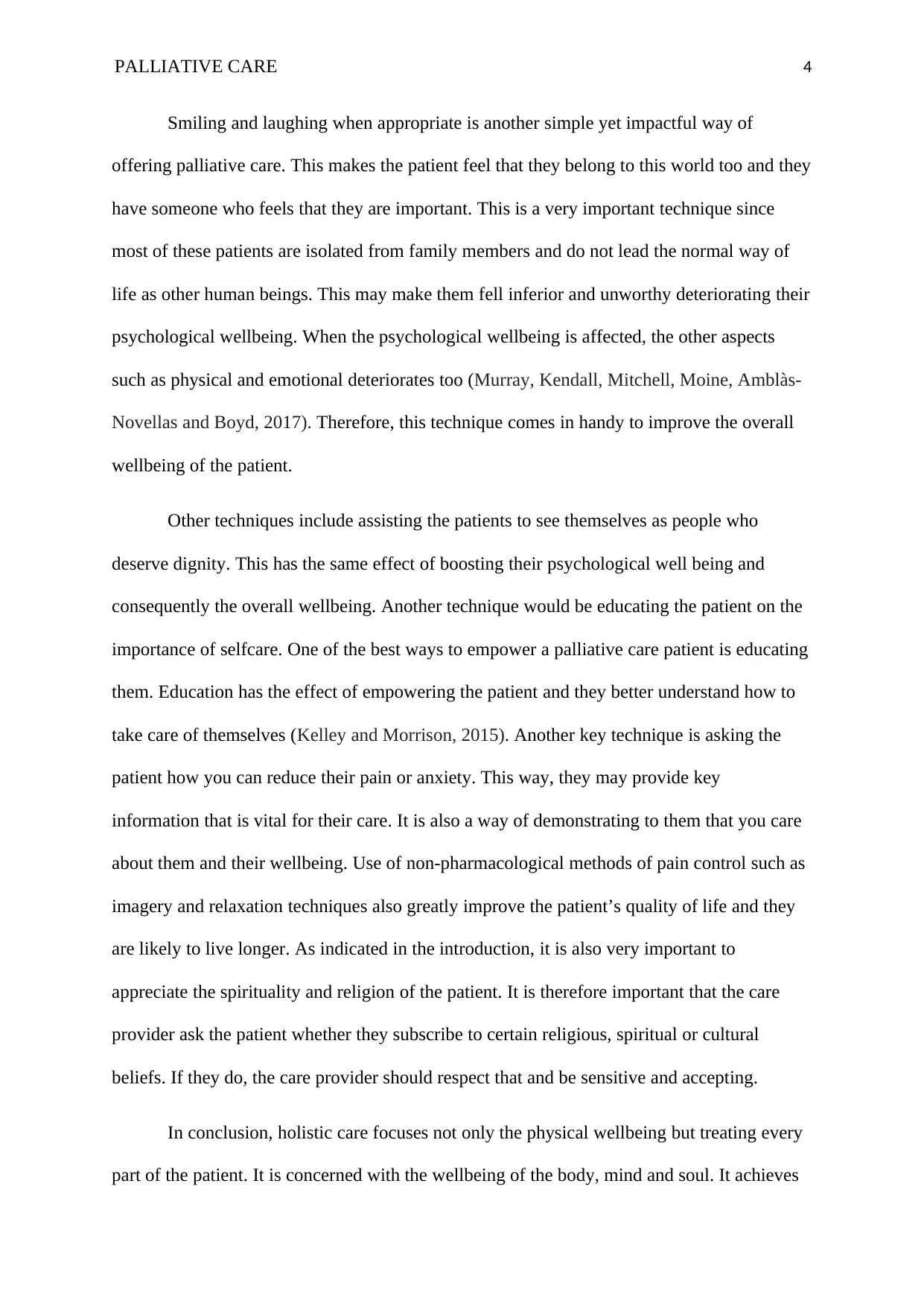
PALLIATIVE CARE 4
Smiling and laughing when appropriate is another simple yet impactful way of
offering palliative care. This makes the patient feel that they belong to this world too and they
have someone who feels that they are important. This is a very important technique since
most of these patients are isolated from family members and do not lead the normal way of
life as other human beings. This may make them fell inferior and unworthy deteriorating their
psychological wellbeing. When the psychological wellbeing is affected, the other aspects
such as physical and emotional deteriorates too (Murray, Kendall, Mitchell, Moine, Amblàs-
Novellas and Boyd, 2017). Therefore, this technique comes in handy to improve the overall
wellbeing of the patient.
Other techniques include assisting the patients to see themselves as people who
deserve dignity. This has the same effect of boosting their psychological well being and
consequently the overall wellbeing. Another technique would be educating the patient on the
importance of selfcare. One of the best ways to empower a palliative care patient is educating
them. Education has the effect of empowering the patient and they better understand how to
take care of themselves (Kelley and Morrison, 2015). Another key technique is asking the
patient how you can reduce their pain or anxiety. This way, they may provide key
information that is vital for their care. It is also a way of demonstrating to them that you care
about them and their wellbeing. Use of non-pharmacological methods of pain control such as
imagery and relaxation techniques also greatly improve the patient’s quality of life and they
are likely to live longer. As indicated in the introduction, it is also very important to
appreciate the spirituality and religion of the patient. It is therefore important that the care
provider ask the patient whether they subscribe to certain religious, spiritual or cultural
beliefs. If they do, the care provider should respect that and be sensitive and accepting.
In conclusion, holistic care focuses not only the physical wellbeing but treating every
part of the patient. It is concerned with the wellbeing of the body, mind and soul. It achieves
Smiling and laughing when appropriate is another simple yet impactful way of
offering palliative care. This makes the patient feel that they belong to this world too and they
have someone who feels that they are important. This is a very important technique since
most of these patients are isolated from family members and do not lead the normal way of
life as other human beings. This may make them fell inferior and unworthy deteriorating their
psychological wellbeing. When the psychological wellbeing is affected, the other aspects
such as physical and emotional deteriorates too (Murray, Kendall, Mitchell, Moine, Amblàs-
Novellas and Boyd, 2017). Therefore, this technique comes in handy to improve the overall
wellbeing of the patient.
Other techniques include assisting the patients to see themselves as people who
deserve dignity. This has the same effect of boosting their psychological well being and
consequently the overall wellbeing. Another technique would be educating the patient on the
importance of selfcare. One of the best ways to empower a palliative care patient is educating
them. Education has the effect of empowering the patient and they better understand how to
take care of themselves (Kelley and Morrison, 2015). Another key technique is asking the
patient how you can reduce their pain or anxiety. This way, they may provide key
information that is vital for their care. It is also a way of demonstrating to them that you care
about them and their wellbeing. Use of non-pharmacological methods of pain control such as
imagery and relaxation techniques also greatly improve the patient’s quality of life and they
are likely to live longer. As indicated in the introduction, it is also very important to
appreciate the spirituality and religion of the patient. It is therefore important that the care
provider ask the patient whether they subscribe to certain religious, spiritual or cultural
beliefs. If they do, the care provider should respect that and be sensitive and accepting.
In conclusion, holistic care focuses not only the physical wellbeing but treating every
part of the patient. It is concerned with the wellbeing of the body, mind and soul. It achieves
Paraphrase This Document
Need a fresh take? Get an instant paraphrase of this document with our AI Paraphraser
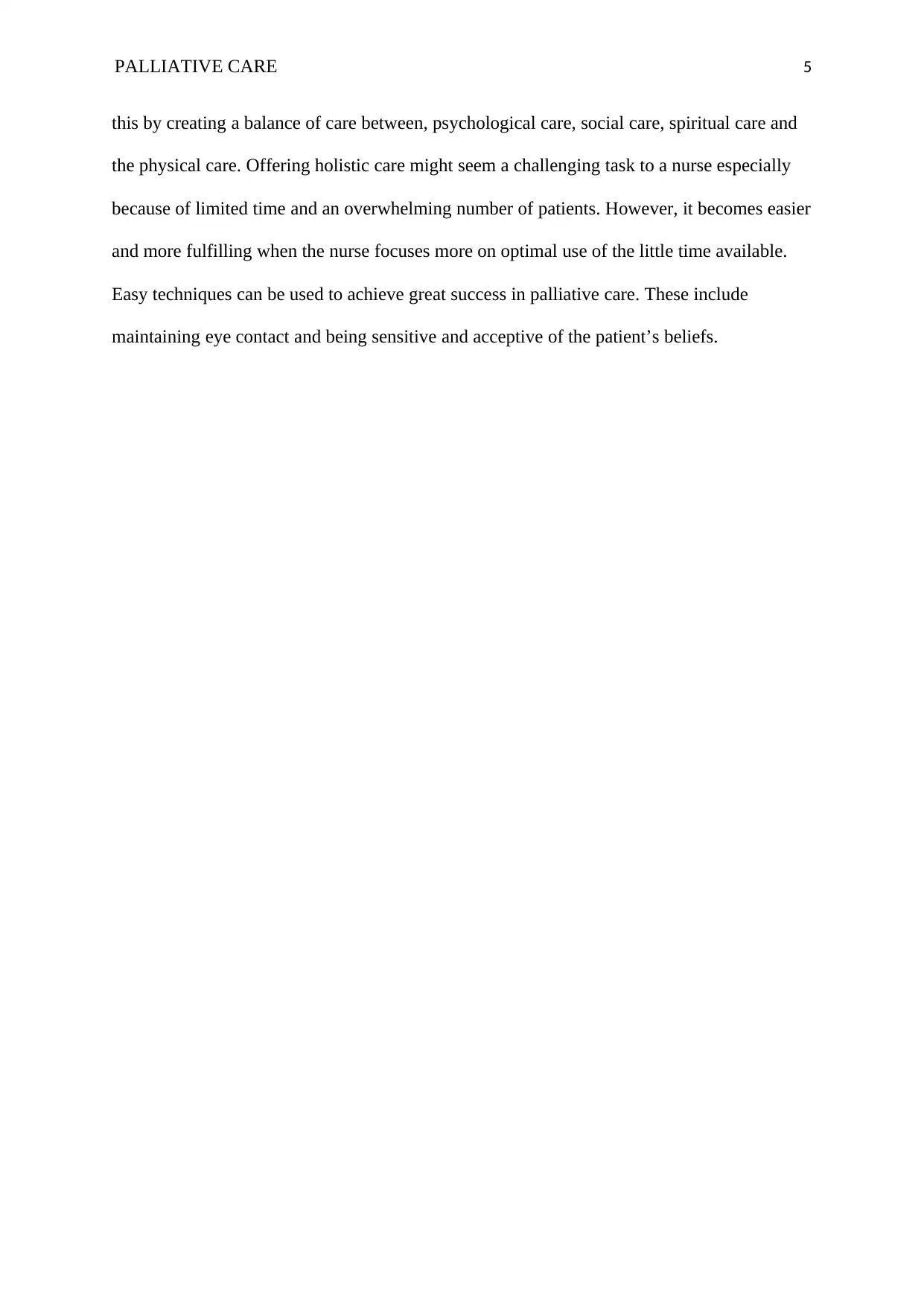
PALLIATIVE CARE 5
this by creating a balance of care between, psychological care, social care, spiritual care and
the physical care. Offering holistic care might seem a challenging task to a nurse especially
because of limited time and an overwhelming number of patients. However, it becomes easier
and more fulfilling when the nurse focuses more on optimal use of the little time available.
Easy techniques can be used to achieve great success in palliative care. These include
maintaining eye contact and being sensitive and acceptive of the patient’s beliefs.
this by creating a balance of care between, psychological care, social care, spiritual care and
the physical care. Offering holistic care might seem a challenging task to a nurse especially
because of limited time and an overwhelming number of patients. However, it becomes easier
and more fulfilling when the nurse focuses more on optimal use of the little time available.
Easy techniques can be used to achieve great success in palliative care. These include
maintaining eye contact and being sensitive and acceptive of the patient’s beliefs.
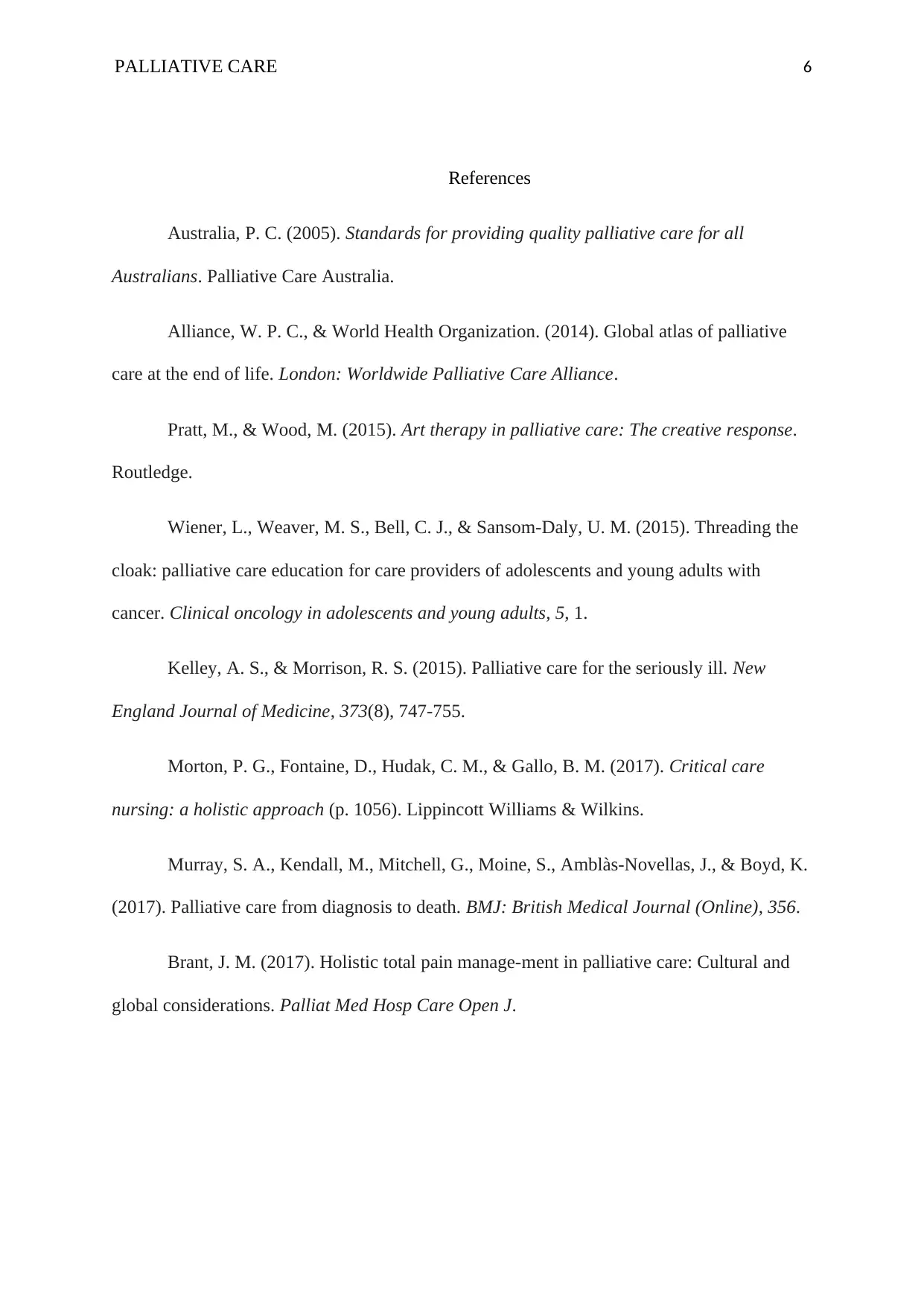
PALLIATIVE CARE 6
References
Australia, P. C. (2005). Standards for providing quality palliative care for all
Australians. Palliative Care Australia.
Alliance, W. P. C., & World Health Organization. (2014). Global atlas of palliative
care at the end of life. London: Worldwide Palliative Care Alliance.
Pratt, M., & Wood, M. (2015). Art therapy in palliative care: The creative response.
Routledge.
Wiener, L., Weaver, M. S., Bell, C. J., & Sansom-Daly, U. M. (2015). Threading the
cloak: palliative care education for care providers of adolescents and young adults with
cancer. Clinical oncology in adolescents and young adults, 5, 1.
Kelley, A. S., & Morrison, R. S. (2015). Palliative care for the seriously ill. New
England Journal of Medicine, 373(8), 747-755.
Morton, P. G., Fontaine, D., Hudak, C. M., & Gallo, B. M. (2017). Critical care
nursing: a holistic approach (p. 1056). Lippincott Williams & Wilkins.
Murray, S. A., Kendall, M., Mitchell, G., Moine, S., Amblàs-Novellas, J., & Boyd, K.
(2017). Palliative care from diagnosis to death. BMJ: British Medical Journal (Online), 356.
Brant, J. M. (2017). Holistic total pain manage-ment in palliative care: Cultural and
global considerations. Palliat Med Hosp Care Open J.
References
Australia, P. C. (2005). Standards for providing quality palliative care for all
Australians. Palliative Care Australia.
Alliance, W. P. C., & World Health Organization. (2014). Global atlas of palliative
care at the end of life. London: Worldwide Palliative Care Alliance.
Pratt, M., & Wood, M. (2015). Art therapy in palliative care: The creative response.
Routledge.
Wiener, L., Weaver, M. S., Bell, C. J., & Sansom-Daly, U. M. (2015). Threading the
cloak: palliative care education for care providers of adolescents and young adults with
cancer. Clinical oncology in adolescents and young adults, 5, 1.
Kelley, A. S., & Morrison, R. S. (2015). Palliative care for the seriously ill. New
England Journal of Medicine, 373(8), 747-755.
Morton, P. G., Fontaine, D., Hudak, C. M., & Gallo, B. M. (2017). Critical care
nursing: a holistic approach (p. 1056). Lippincott Williams & Wilkins.
Murray, S. A., Kendall, M., Mitchell, G., Moine, S., Amblàs-Novellas, J., & Boyd, K.
(2017). Palliative care from diagnosis to death. BMJ: British Medical Journal (Online), 356.
Brant, J. M. (2017). Holistic total pain manage-ment in palliative care: Cultural and
global considerations. Palliat Med Hosp Care Open J.
⊘ This is a preview!⊘
Do you want full access?
Subscribe today to unlock all pages.

Trusted by 1+ million students worldwide
1 out of 6
Related Documents
Your All-in-One AI-Powered Toolkit for Academic Success.
+13062052269
info@desklib.com
Available 24*7 on WhatsApp / Email
![[object Object]](/_next/static/media/star-bottom.7253800d.svg)
Unlock your academic potential
Copyright © 2020–2025 A2Z Services. All Rights Reserved. Developed and managed by ZUCOL.




